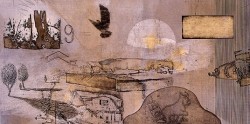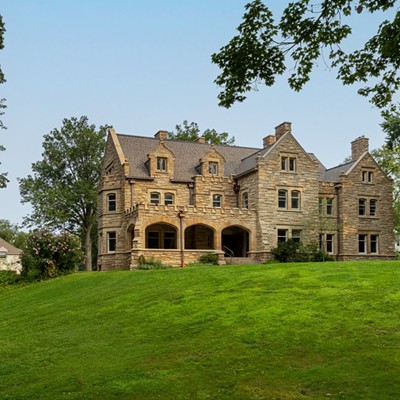There's lots of landscape on the way from Cleveland to Oberlin's Firelands Association for the Visual Arts (FAVA). Unless you're transported there in a blindfold, you get to see a characteristic range of Rust Belt scenery: Battered inner-ring and downtown real estate sinks below the surreal swoops and long slow curves of the interstate.
If the three artists in the exhibit Views, currently on display at FAVA Gallery, have anything in common, it's a need to sort through the visual realities of the early 21st-century American 'scape and make sense of it.
They aren't tourists, but they approach their itinerary more as storytellers or working journalists. This is a point made forcefully by Ohio-born, Chicago-based John Benton in his relatively small oil-on-canvas works. Typically about 3 feet long and just over a foot tall, paintings like "Salt Pile With Skimming Platform" have a panoramic orientation designed to arouse big expectations. Already the viewer is being primed for disorientation, if not necessarily disappointment: In a painting or in real life, a salt pile is not Mount Kilimanjaro. Yet Benton paints it as if it were some similarly iconic feature, as if to say, such are our mountains.
It's a postcard describing, and perhaps honoring, the banal. This isn't a new idea in painting. From the mid-19th century, some version of what the philosopher Arthur C. Danto called "The Transfiguration of the Commonplace" has been a guiding principle for artists ambitious to claim a place among the realities of their time.
Benton's views here - a baseball diamond surrounded by trees in late afternoon, cars at an industrial park - are painted in a curiously uninflected manner. Though highly detailed, there is no flair in the execution, no local bursts of emphasis, no brushy patches or variations in line quality that would convey a sense of the unique hand of the artist; it's as if Benton, in his anxiety to get each thing right, erases himself - but of course this in itself constitutes a stylistic, personal stance. The light also seems deliberately dimmed in many of these works, as if the sun were in partial eclipse. The artificiality of this deadpan manner is ultimately the subject of Benton's work and perhaps expresses a deep pessimism about whether beauty can be found and recovered from a largely artificial world.
By contrast, Cleveland-area printmaker Glenn Ratusnik, working out of Zygote Press, immerses himself in the quirks and thrills, conditions and possibilities of the intaglio process. His 10 etchings, essentially untitled under the general designation "State Proof," use landscape to suggest a tale of ongoing psychological transformation. All are versions of the same plate, but unless you pay careful attention to the progressive erosion and replacement of lines and images in the series, you'd never know. The first is actually an etched photograph of colonial-style houses in a new real estate development. No trees or other signs of long-term habitation are evident - just a few cars, an empty sky and a menacing expectancy. In the next version, Ratusnik has scraped away most of the central house. On the left, the outline of a crow, wings spread wide, soars into the picture plane like a huge shadow. As the saga continues, the entire original scene is first fragmented and replaced by interior detail - furnishings, a radioactive-looking pet - after which everything disappears, as if a curtain had been drawn. In "State Proof #4" only a rich, uniform blackness remains, as in a darkened room; a covered ceiling lamp, like an upside-down bowl, dominates the upper half of the composition. In "#7," only blips and scratches murmur unintelligible testimony in a fog-bound world. But the death of one kind of reality signals the birth of a pared-down, almost post-apocalyptic imaginative realm depicted in the final three plates.
Apocalypses, post and present, have become the stock in trade of nationally known Cleveland-based painter Amy Casey. Painting meticulously on etching paper with tiny brushes and a muted acrylic palette, Casey produces nearly frolicsome scenes of impossible urban disarray, uprooting all kinds of city properties and piling them up like toys in the corners of an overcrowded playroom. In "Two Cities," a brace of such impromptu towers, held together with tenuous guylines and wishful thinking, reach out to one another with weightless lengths of stockade fencing, like arms withered by long disuse.
There is little or no gravity in Casey's reconstructed cities, merely a supporting ether of negative space. "Two Cities" uses this cut-out quality to suggest a poignant isolation, as the vertical jumbles (the tower on the right is a downtown mix of factories, hotels and smaller office buildings, like ungainly acrobats balancing on each other's shoulders) fail to make contact. Are the two cities in question Cleveland and Casey's native Erie? Cleveland and New York? Cleveland and Cleveland? Sodom and Gomorrah? Whatever or wherever the structures may be, it seems likely their new configuration is an improvement. Other Casey works at FAVA, like "Congested" or "Drifting," show what appear to be parts of a vast migration of mainly older houses, tied together by strong ropes. Maybe aliens are floating them off for sale on other planets or to stock inter-dimensional suburbs. Or maybe what we're seeing are giant fishnet Christmas stockings stuffed full of the latest foreclosures - tribute for the native Terrans in charge of our own disheveled dimension.












